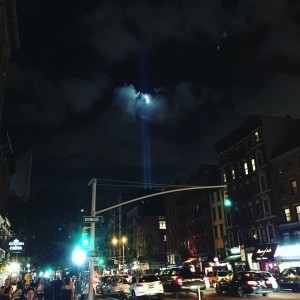Remembering Marcy Borders (August 12, 1973-August 24, 2015)
Few images define the haunting terror of the September 11, 2001, attacks better than the picture of Marcy Borders. Borders, then a Legal Assistant at Bank of America, worked on the 81st floor of the North Tower, and somehow managed to escape and survive its destruction. The quick shutters of a camera lens etched her rescue into American history.
Photo Credit: Stan Honda, AFP/Getty Images
In the iconic picture, Borders was impeccably dressed in a knee-length skirt, a fitted sweater, a necklace, small hoop earrings, tights, and calf-high boots. Yet the color of her well-fitted attire is indeterminable because of her surroundings—a cloud-cover of yellowish dust. While nearly consumed by ash and surrounded by a thick coating of unspecified debris, the look of fear in Borders’s eyes, her hands outstretched and mouth agape, confirm that something is not quite right, and that the seeming stillness of the image belies the chaos occurring outside the frame. In that arresting moment, the image of a black woman became a powerful symbol for the popular remembrance of a devastating event.
Reportedly, Borders rarely viewed the image because of the ways it reminded her not only of that fateful day, but also how she lived when others she knew and who had worked with her had not. She seemed to struggle with the trauma of that day, and with the transition from victim to survivor.
In a video interview with CNN in 2002, a mere six months after the attacks, Borders offered a synopsis of how the events of September 11, 2001 had stayed with her:
“I’m still on 9/11, I can’t get it out of my head and I wish…oh Lord I just wish that I could just have a peace of mind…and I know everybody has life situations, there are some people who wake up with no cure to their disease, but at the same time, I just have a lot on my brain and I’ve never had so much on my brain.”[1]
In a foreshadowing of what would become her own battle with a terminal disease, Borders spoke uncannily of the ways the events of September 11th would continue to trouble the American imagination. The desire for a collective peace of mind is a sentiment that continues to go unresolved, especially in light of the acts of violence tormenting our country almost daily.
Especially haunting are Borders’s own words about her fight with stomach cancer, which came after years of battling substance abuse and depression—more lingering effects of 9/11. In November 2014, she spoke to The Jersey Journal about her illness stating:
“I’m saying to myself, ‘Did this thing ignite cancers cells in me?’ I definitely believe it [did] because I haven’t had any illnesses. I don’t have high blood pressure…high cholesterol, diabetes…How do you go from being healthy to waking up the next day with cancer?”[2]
In her documented exasperation at the residue of 9/11, Borders was actually on to something. According to CNN and the CDC, “3700 survivors and first responders at the Word Trade Center site have been diagnosed with cancers” resulting from the chemical carcinogens released during the collapse of the towers.[3] Notably, reporting from the CDC “cites the very few peer-reviewed study reports that contain any quantitative data about cancer as a health outcome resulting from September 11, 2011 exposures.”[4] We also continue to live with the remains of 9/11.
I happened to be in New York City on September 11, 2015. As my husband and I traversed lower Manhattan with our two-year old literally on our backs, it was not the memories of where I was and what I was doing on that day that captured my immediate musings as was usually the case on September 11th. Rather, it was the life—and death— of Borders, “The Dust Lady” that held my thoughts. Seeing the lights commemorating where the Twin Towers had been reminded me in a profound way of the men and women who survived the events of September 11, 2011.
Lower Manhattan, September 11, 2015[5]
I was struck by an overwhelming sadness for someone who transitioned at such a young age (42) and from such a painful, debilitating illness. I thought of the loved ones Borders left behind, including her two children, husband, extended family, and communities of people who continue to speak admirably of her tenacity and grit—her ability to survive despite the odds.
Marcy Borders died while bearing upon her body the enormous burdens of a historical event. She was a symbol of survival during a time of literal and symbolic loss. As we continue to wrestle with the lasting implications of that time, may we draw from her strength. RIP Marcy Borders. May your story continue to live beyond the limits of a photograph.
[1] See the video, “2002: Story Behind 9/11 ‘Dust Lady’ Photo.” http://www.cnn.com/2015/08/26/us/9-11-survivor-dust-lady-dies/
[2] Reported by Jonathan Lin, November 27, 2014. The Jersey Journal. http://www.nj.com/hudson/index.ssf/2014/11/911_survivor_dust_lady_faces_a_new_demon_stomach_cancer.html.
[3] http://www.cnn.com/2015/08/26/us/9-11-survivor-dust-lady-dies/
[4] “First Periodic Review of Scientific and Medical Evidence Related to Cancer for the World Trade Center Health program,” iii. http://www.cdc.gov/niosh/docs/2011-197/pdfs/2011-197.pdf
[5] Photo courtesy of author.
Copyright © AAIHS. May not be reprinted without permission.



Rhon: Thanks for writing such a lovely and moving piece on Marcy’s life.
KNB
A stunning, and devastating, story, photograph, and event. As a journalist and “observer,” I must ask, “What was in the dust?” Marcy Borders’ family and community, the public and the world, all deserve answers to that question, and many more. May her spirit find infinite comfort and rest.